|
The Daibutsu or the Great Buddha of Kamakura
(鎌倉大仏)
|
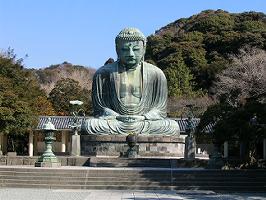 **The full inspection and conservation works were completed on Mrarch 10, 2016, that had started on January 13. The body has been damaged by natural elements: polluted air and acid rain. Further worse, pieces of spat chewing gum were found.
**The full inspection and conservation works were completed on Mrarch 10, 2016, that had started on January 13. The body has been damaged by natural elements: polluted air and acid rain. Further worse, pieces of spat chewing gum were found.
The inspection proved that the Daibutsu is rather in better condition than expected. Also the sesmic isolation device under the body was checked and proved to function normally. Completely clearned, now the Daibutsu is seated calmly with a fresh countenance, keeping its magnificence.**
Full name: Taiizan Kotokuin
Shojosenji (大異山高徳院清浄泉寺)
Denomination: Jodo sect of Buddhism
Location: Five hundred meters north of Hase Station on
the Enoden Line.
History:
The Daibutsu is the one of the major landmarks and most popular tourist spots in Kamakura, but many facts about it are buried in the mist of history.
The creation can be traced to the time when Minamoto no Yoritomo (源頼朝, 1147-99) established his government in Kamakura. In 1185, he had
attended the inauguration ceremony of the Nara Daibutsu, which was
reconstructed after destruction in 1180 at the hands of warriors of
the rival Heike clan. The colossal statue at Nara inspired him to
create a monumental counterpart in the east. He was not, however,
able to realize this dream. It was left to Inadano Tsubone (稲多野局, ?-?),
who had served Yoritomo, to carry out his wishes, presumably with
the support of Hojo Masako (北条政子, 1157-1225), Yoritomo's wife. Joko (淨光, ?-?), a
priest, traveled about the country to raise funds for the project.
According to the Azumakagami (吾妻鏡), official records of the
Kamakura government covering the years 1180 to 1266, construction of
a wooden image was begun in 1238 and completed in 1243, together
with a huge wooden hall that housed the statue. Reconstruction of a new gilded image, this one of bronze, was begun in 1252, but no records remain
concerning its completion or even who was in charge of the casting,
although this is vaguely attributed to Tanji Hisatomo (丹治久友), Ono
Goroemon (大野五郎右衛門, ?-?) or Mononobe Shigemitsu (物部重光, ?-?).
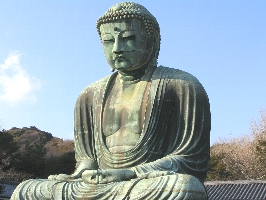 The hall itself, repeatedly damaged by storms and earthquakes, was finally washed away altogether in the late 15th
century by a tsunami, leaving the statue in the open air ever since.
This gave rise to the statue being referred to as the Roza no
Daibutsu (露座の大仏), the open-air Buddha. Over the years, this exposure
to the elements has taken its toll. The Great Kanto Earthquake of
1923 caused the statue to shift forward some 50 centimeters,
although this was later corrected. In 1961, the statue underwent
cosmetic surgery to reinforce it, the traces of which contrast
sharply with the original joints.
The hall itself, repeatedly damaged by storms and earthquakes, was finally washed away altogether in the late 15th
century by a tsunami, leaving the statue in the open air ever since.
This gave rise to the statue being referred to as the Roza no
Daibutsu (露座の大仏), the open-air Buddha. Over the years, this exposure
to the elements has taken its toll. The Great Kanto Earthquake of
1923 caused the statue to shift forward some 50 centimeters,
although this was later corrected. In 1961, the statue underwent
cosmetic surgery to reinforce it, the traces of which contrast
sharply with the original joints.
Grounds: The temple grounds are entered through a vermilion gate, called Niomon (仁王門), beside the ticket office. In each recess of the gate is a fierce-looking Nio (仁王), a guardian deity of temples. The red-colored Nio on the right (as you face them) has his mouth open, so that he appears to be uttering "ah" (阿), which means "the beginning." The blue-colored Nio, however, has his mouth closed and is uttering "un" (吽), which means "the end." The combination of "ah" and "un" is similar to references to alpha and omega - everything from beginning to end. The Nio stand guard to prevent evil from entering the temple.
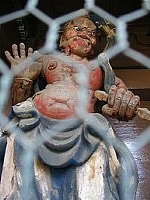
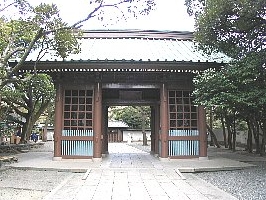
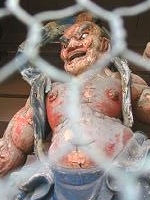
The Great Buddha is acclaimed for its noble countenance and peaceful repose. It represents Amida Nyorai (阿弥陀如来), the Buddha of light, and is designated a National Treasure. The Buddha's features attest to the high sculptural skills of the artisans of the Kamakura period. With eyes half open, the statue appears to be almost smiling. The head is covered with 656 curls known as rahotsu (螺髪). In the middle of the forehead is a round protuberance called byakugo (白毫), made of white silver that supposedly emits light to all the world. The upper section of the body is proportionately larger than it should be, but this device, along with the sloping shoulders, provides a more natural appearance when the statue is viewed from the front at a distance of about five meters.
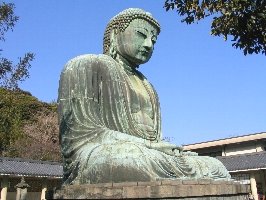
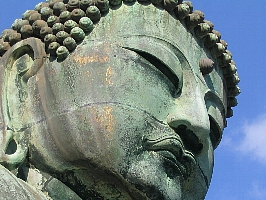
The Great Buddha stands 12.3 meters high, has a face 2.56
meters long, and eyes one meter long. Each eyebrow measures 1.24
meters across, the mouth 0.82 meters, and the ears are 1.9 meters
long. The statue is made of bronze and weighs 120 tons. Traces of the original gilt are still visible on the right temple and on the lower right side of the cheek.
On entering the hollow statue from the left side of the body (the right side as you face it), the first thing to meet the eyes is a seated version of the guardian deity of Yoritomo. There is also an image of Yuten (祐天, 1637-1718), the priest who restored the temple during the Edo period. A bronze
tablet explains the work he carried out.
Behind the statue stand four big bronze lotus petals. They were cast in the mid Edo period (1603–1867) for a lotus pedestal on which the Great Buddha was to be seated. The plan was abandaned halway, leaving only four petals far shorter than planned 32 casting. The donator's names are still seen on the surfaces.
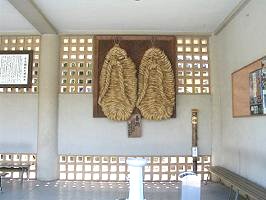 On the wall of the corridor to the right of the statue (when you face it) is a pair of huge waraji (草鞋), straw sandals, 2.8 meters long, a donation from school children in Ibaraki Prefecture. The offering was an expression of
gratitude for a good harvest, and was accompanied by a message from
the children: Buddha must surely be tired after sitting there for
some 700 years and they would be pleased indeed if he were to wear
the sandals when he takes a walk. By present-day calculations,
should the Buddha actually walk to Tokyo, he would reach there in
approximately one hour, since his pace would be equivalent to the
speed of a train.
On the wall of the corridor to the right of the statue (when you face it) is a pair of huge waraji (草鞋), straw sandals, 2.8 meters long, a donation from school children in Ibaraki Prefecture. The offering was an expression of
gratitude for a good harvest, and was accompanied by a message from
the children: Buddha must surely be tired after sitting there for
some 700 years and they would be pleased indeed if he were to wear
the sandals when he takes a walk. By present-day calculations,
should the Buddha actually walk to Tokyo, he would reach there in
approximately one hour, since his pace would be equivalent to the
speed of a train.
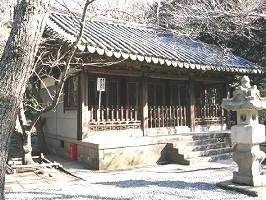
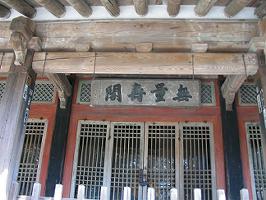
To the rear of the compound is Kangetsudo Hall (観月堂), "Moon-viewing Hall." This structre was once located in the imperial palace in mid-15th century Hanyang (present-day Seoul), Korea. Being brought to Tokyo, in 1924 the owner donated this to the temple here. The structure exemplifies the traditional Korean style in those days, which can be seen on the door and windows in the front and in the motif on the end tiles of the roof.
The Hall houses a standing image of Kannon (観音) created in the late Edo period (江戸時代).
In the grove to the right of Kangetsudo is a 2-meter stone monument bearing a poem composed by the famous poet, Yosano Akiko (与謝野晶子, 1878-1942). The inscriptions on both sides of the monument are hardly visible. Those on the right side (as you face it) reads,
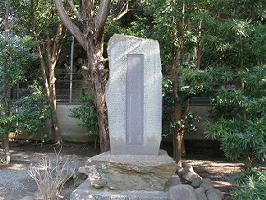
"Here in Kamakura
Sits Sakya-Muni,
The Holy Buddha,-
A handsome figure
Among the summer trees."
Constructed
on
the seven hundredth
anniversary
of
the Great Buddha.
by
AJINOMOTO CO. INC
April 8th, 1952 "
|
Her poem acknowledges that Buddha should, of course, be honored foremost for being Shakyamuni, but she also praises him for his good looks.
Yosano seems to have been a better poet than theologian, because she
apparently failed to recognize that the statue represents Amida
Nyorai, not Shakyamuni. However, the use of the word, Shakyamuni,
rather than Amida adds a sense of humanity to this poem. Kawabata
Yasunari, Nobel Prize winner for Literature in 1968, referred to the
above fact in his novel, Yama no oto (山の音, The Sound of the
Mountain, 1970).
|
|
The Former Site of Kuwagayatsu Sanitarium (桑ケ谷療養所跡)
|
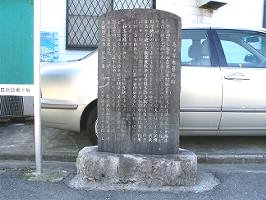 A small stone recessed in a residential area, one hundred meters and on the right side from the Great Buddha, marks the former site of
Kuwagayatsu Sanitarium. In the 1260s, regent Hojo Tokimune (北条時宗, 1251-84)
requested Ninsho (忍性, 1217-1303), a celebrated priest at Gokurakuji
Temple (極楽寺), to establish a sanitarium in this valley to aid people
suffering from disease. He also provided meals to people who were
suffering from hunger caused by drought. Over a 20-year span, he is
said to have helped some 60,000 people. Regrettably, nothing else
remains to testify to Ninsho's great charitable undertakings here.
A small stone recessed in a residential area, one hundred meters and on the right side from the Great Buddha, marks the former site of
Kuwagayatsu Sanitarium. In the 1260s, regent Hojo Tokimune (北条時宗, 1251-84)
requested Ninsho (忍性, 1217-1303), a celebrated priest at Gokurakuji
Temple (極楽寺), to establish a sanitarium in this valley to aid people
suffering from disease. He also provided meals to people who were
suffering from hunger caused by drought. Over a 20-year span, he is
said to have helped some 60,000 people. Regrettably, nothing else
remains to testify to Ninsho's great charitable undertakings here.
|
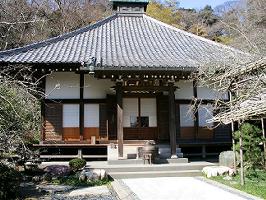 Full name: Gyojisan Kosokuji (行時山光則寺)
Full name: Gyojisan Kosokuji (行時山光則寺)
Denomination: Nichiren sect of Buddhism (日蓮宗)
Location: Three hundred meters northweast of Hase Station on the Enoden Line.
History:
The temple grounds were originally the site of the residence of one Yadoya Yukitoki (宿谷行時, ?-?), a retainer of the fifth regent Hojo Tokiyori (北条時頼, 1227-63). The story goes back to a time some 700 years ago when Nichiren (日蓮, 1222-82), the founder of the Nichiren sect of Buddhism, came to Kamakura to spread his teachings.
In those days, the entire country was beset by earthquakes, fires, plagues, and other disasters. Nichiren asserted that the miserable state of affairs was caused by mistaken thinking on the part of the people rather than by disastrous natural events, and warned against believing in misleading sects such as the Nembutsu (念仏), Zen (禅), Shingon (真言), and Ritsu (律), adding that when all the people came to possess the true faith - that of Nichiren - the country would become peaceful and secure.
On July 16, 1260, Nichiren visited a devoted follower, Yadoya Yukitoki, and explained the thinking behind his book, Rissho Ankokuron (立正安国論), A Treatise on Pacifying the Nation by Establishing Orthodoxy, and asked Yukitoki to submit it to Hojo Tokiyori. Nichiren continued his activities, preaching his teachings based on the Lotus Sutra, which, he claimed, was the only true one. Such attacks incurred eventually the wrath of the government. Nichiren was duly arrested and taken in 1271 to Tatsunokuchi (竜ノ口) in Katase (片瀬) for execution. Among his followers, the priests Nichiro (日朗, 1243-1320) and Nisshin (日真) and Shijo Kingo and his son were also taken into custody and confined in a cave within the grounds here, although they were treated kindly because their keepers, Yukitoki and his son, Mitsunori (光則, ?-?), were of the same faith. Nichiren miraculously escaped execution but was exiled to Sado Island (佐渡). Following three years of hardship in exile, he was pardoned in 1274, and in the same year, after a brief stay at a hermitage here in Kamakura, he retired to Mt. Minobu (身延山, in present-day Yamanashi Prefecture), which later became the headquarters of the Nichiren sect of Buddhism.
Some years later, Yadoya Mitsunori assumed a high government position. He never abandoned his faith and went so far as to convert his home into a temple (the present-day Kosokuji), inviting Nichiro as the founding priest.
"Gyojisan," the temple sango (prefix to the temple name), is another reading of Yukitoki's name (行時), and “Kosukiji," the temple name, is another reading of his son's name, Mitsunori (光則). Accordingly, the full name of this temple is 行時山光則寺 (Gyojisan Kosokuji).
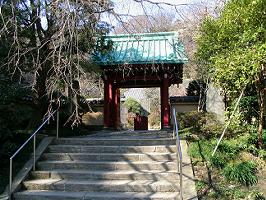 Grounds:
Between the vermilion entrance gate and main hall is a beautiful garden that displays flowers of the season. One of the aronia trees (kaido, 海棠) is 150 years old and seven meters high. The trees bloom from late March to early April, attracting many flower lovers.
Grounds:
Between the vermilion entrance gate and main hall is a beautiful garden that displays flowers of the season. One of the aronia trees (kaido, 海棠) is 150 years old and seven meters high. The trees bloom from late March to early April, attracting many flower lovers.

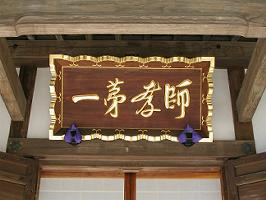
The Main Hall, built in 1650, has a wooden tablet over the entrance bearing the characters 師孝第一 (shiko daiichi), an expression exhorting loyalty to one's teacher. These words are attributed to Nichiren, and spoken to Nichiro, a leading disciple. The Main Hall houses images of Nichiren and Nichiro, but is not open to the public.
Within the grounds stands an imposing stone monument inscribed with an excerpt from Nichiren's Rissho Ankoku Ron. A stone tablet explaining the meaning of the inscription stands next to the monument.
To the left is a stone monument commemorating Miyazawa Kenji (宮沢賢治, 1896-1933). It is inscribed with his famous poem: “Ame nimo makezu"
(雨ニモマケズ...") (“Neither rain nor wind...").
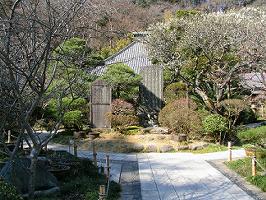
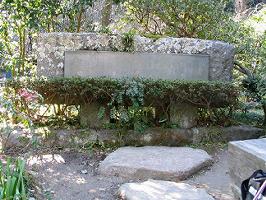
A flight of some 100 stone steps to the right of the priest's living quarters, or Kuri (庫裏), leads up the hillside. At the top, after passing in front of two gravesites, is a shallow cave some five meters square. It is here that the priest Nichiro was once confined.
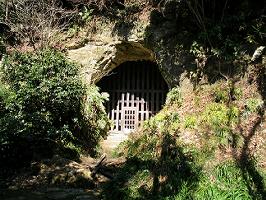
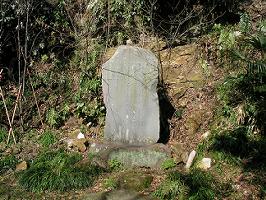
A disciple of Nichiren from the age of 13, he served his master faithfully. When, in 1261, Nichiren was to be exiled to Izu (伊豆), Nichiro beseeched the authorities to allow him to accompany him, but permission was denied. And in 1271, when Nichiren was given the death sentence, this faithful follower was confined in the cave here under the same charge that had been brought against Nichiren. Nichiren himself was saved from execution, and on the day prior to his departure for exile on Sado Island (佐渡島), he sent Nichiro a letter that came to be known as Tsuchinoro Gosho (土の牢御書).
These events and the contents of the letter are immortalized on the stone monument that stands to the left of the cave. The letter's message: “Most people chant Hokekyo (法華経) but only a few believe in it. And even if they believe in it, they do not put their belief into practice. But you, Nichiro, have mastered the teachings of Hokekyo, and will thus be able to
overcome any hardship. After you are pardoned, come to me in Sado as
soon as possible." The letter conveys Nichiren's concern for his
disciple even at a time when he himself was facing exile, a fate
equivalent to the death penalty.
|
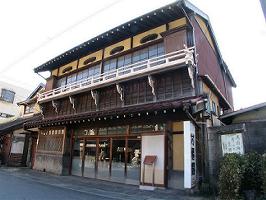
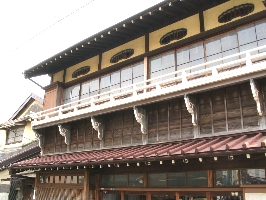
An inn-style structure stands along the street leading to Hasedera Temple. The signboard is inscribed with the characters, 対僊閣.
Built in 1904, its notable features are at the front: handrails, brackets, and transom windows on the second level. All these decorative fixtures remind passers-by of its one-time prosperity, when the street in front was thriving with worshippers to Hase Temple and the inn was serving them at full capacity. The structure is the only one remaining in Kamakura that retains features that go back to the beginning of the 20th century and has been designated a building of important architectural value by the city.
|
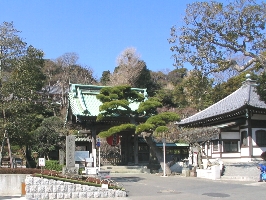 Full name:
Kaikozan JIshoin Hasedara (海光山慈照院長谷寺)
Full name:
Kaikozan JIshoin Hasedara (海光山慈照院長谷寺)
Denomination:Jodo sect of Buddhism
Location:Three hundred meters northwest of Hase Station on the Enoden Line.
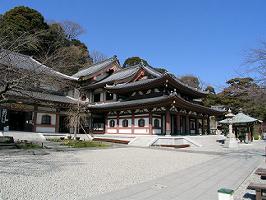 History:
The temple is said to have been founded in 736 by Tokudo (徳道), a priest, who is also credited with the founding of the renowned Hasedera in Nara Prefecture. The main target of worship, the large gilded statue of an eleven-faced Kannon, is also attributed to him. (However, these have never been substantiated.)
History:
The temple is said to have been founded in 736 by Tokudo (徳道), a priest, who is also credited with the founding of the renowned Hasedera in Nara Prefecture. The main target of worship, the large gilded statue of an eleven-faced Kannon, is also attributed to him. (However, these have never been substantiated.)
The temple may have flourished during the Kamakura period, for the inscription on the temple bell to the year 1264. It is said that some members of the Ashikaga clan (足利), the ruler during the Muromachi period (1336-1573), and Tokugawa Ieyasu (徳川家康, 1542-1616) in the Edo period came here to worship and that temple prospered as one included in a 33-circuit pilgrimage to Kannon in the Kanto region (関東三十三ケ所観音霊場).
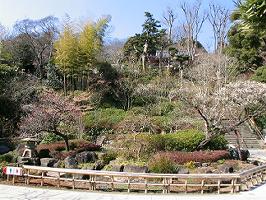 Grounds:
Visitors have a choice of two routes when they tour the grounds. They may either proceed directly toward the staircase on the hillside that leads to the upper grounds or they may stroll around the garden, watching the carp swimming leisurely and enjoying various flowers of the season: cherry blossom, plum blossom, peony, and iris.
Grounds:
Visitors have a choice of two routes when they tour the grounds. They may either proceed directly toward the staircase on the hillside that leads to the upper grounds or they may stroll around the garden, watching the carp swimming leisurely and enjoying various flowers of the season: cherry blossom, plum blossom, peony, and iris.
Climbing the stone stairway, which provides an increasingly wider view, visitors will reach the upper grounds that contain the huge Kannondo Hall (観音堂), several minor halls, an observation terrace, and more.
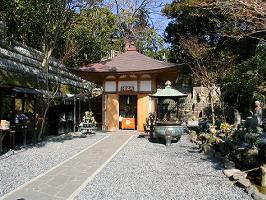 Before reaching the upper ground and halfway up the staircase is Jizodo Hall (地蔵堂) on a plot leveled from the hillside. Within that area stand countless rows of small statues of Jizo (地蔵) Buddha, popularly known as Mizuko Jizo (水子地蔵). Jizo, the patron saint of children, is familiar to all Japanese; but when seen in such large numbers, the statues create a strange world, one beyond our own. In fact, the statues are dedicated to the souls of stillborn or aborted babies, and are a reflection of parental prayers that Jizo protect and guide the souls in the afterlife. The main figure here of Jizo portrays him as if he is about to step forward to embrace the newly arrived souls.
Before reaching the upper ground and halfway up the staircase is Jizodo Hall (地蔵堂) on a plot leveled from the hillside. Within that area stand countless rows of small statues of Jizo (地蔵) Buddha, popularly known as Mizuko Jizo (水子地蔵). Jizo, the patron saint of children, is familiar to all Japanese; but when seen in such large numbers, the statues create a strange world, one beyond our own. In fact, the statues are dedicated to the souls of stillborn or aborted babies, and are a reflection of parental prayers that Jizo protect and guide the souls in the afterlife. The main figure here of Jizo portrays him as if he is about to step forward to embrace the newly arrived souls.
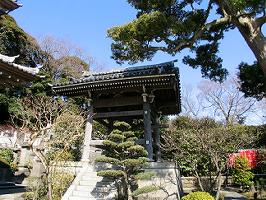 The Main Hall is further up, at the top of the stairway. To the right, as you face it, is a wooden bell tower. The bell, cast in 1984, to replace the old one which was made in the Kamakura period (1185/92-1333), is now housed in the Treasure Hall, and is struck each evening to announce the time.
The Main Hall is further up, at the top of the stairway. To the right, as you face it, is a wooden bell tower. The bell, cast in 1984, to replace the old one which was made in the Kamakura period (1185/92-1333), is now housed in the Treasure Hall, and is struck each evening to announce the time.
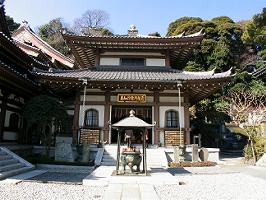 To the left is Amidado Hall (阿弥陀堂), with a seated image of Amida Nyorai (阿弥陀如来) 2.8 meters high. Amida is said to reside in the Western Paradise and to descend to this world to receive a believer on his deathbed. The Amida under the canopy here, like most depictions of this Buddha, has a benevolent appearance. Tradition says that Minamoto no Yoritomo (源頼朝, 1147-99) had this image made to ward off the bad fortune associated with the forty-second year of a man's life. The statue was probably made at a much later date.
To the left is Amidado Hall (阿弥陀堂), with a seated image of Amida Nyorai (阿弥陀如来) 2.8 meters high. Amida is said to reside in the Western Paradise and to descend to this world to receive a believer on his deathbed. The Amida under the canopy here, like most depictions of this Buddha, has a benevolent appearance. Tradition says that Minamoto no Yoritomo (源頼朝, 1147-99) had this image made to ward off the bad fortune associated with the forty-second year of a man's life. The statue was probably made at a much later date.
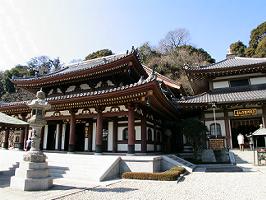
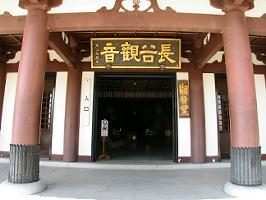
Next to Amidado Hall is the huge Kannondo Hall, completed in 1986. Inside is a beautifully painted ceiling and a large gilded statue of an eleven-faced Kannon (十一面観音) against a red background. In its left hand, the statue holds a vase containing a lotus flower. In its right it holds a staff, conveying the idea that Kannon herself will go to people needing help. There are eleven smaller heads on the large main head: three at the front, three each to the right and left, one at the top, and one on the back. The facial expressions vary, indicating attentiveness to all human needs and that salvation is offered to all beings. The gilded halo behind the body, restored in 1991, adds to the statue's grandeur. The 9.12-meter image is said to be the tallest of all statues in Japan made from a single piece of wood. To the right of the main image is a statue of Tokudo (徳道), the temple's founding priest, and one of Emmei Jizo (延命地蔵), the Life-Prolonging Jizo.
To the left of the main hall is a two-storied Treasure Hall, or Homotsukan (宝物館), constructed in 1980. The exhibits are occasionally changed. The main attraction on the first floor are some two-meter stone slabs, itabi (板碑). Such slabs were generally made in commemoration of the departed, and were accompanied by an image of Buddha or a Sanskrit letter symbolizing Buddha. The tablet, called hokyointo-yokoku-itabi (宝篋印塔陽刻板碑), is very rare because of its height (2.6 meters) and the fact that it shows an era name and date 徳治三年, which corresponds to the year 1308.
Two large ema (絵馬), or votive tablets, both 1.5 meters wide, hang on the wall. Originally, when people made their devotions, they offered horses to the shrine or temple, but with the passage of time a painted horse took the place of a real one and tablets with various paintings and prayers gradually evolved. Each of the tablets here has a horse in relief and the inscription of an era date, 正保三年 (1646).
Next to the ema is a waniguchi (鰐口), literally, “crocodile mouth." This metal drum is usually hung above the entrance of a temple hall. Visitors announce their presence by striking it with a rope attached to an overhead beam. The size of this waniguchi reflects the large scale of the temple.
The next object on display is a bell that has been designated an Important Cultural Property. It is 1.7 meters high and 0.9 meters in diameter. The inscription indicates it was made in 1264 by Mononobe Sueshige (物部季重), a iron caster. The bell also bears the name of the temple: Shin-Hasedera (新長谷寺), reputedly the oldest of all bells that bear a temple name.
Other objects displayed on this floor are the kawarake (かわらけ), a type of tableware made of unglazed pottery, and pots called tokoname-tsubo (常滑壷) from the Muromachi period (1333-1568).
Up on the second floor is a display of old coins that date from the 15th to 16th centuries and imported from Sung dynasty China. All were unearthed from the temple grounds.
The front wall-case displays six kakebotoke (懸仏), a Buddhist image in relief on a round board to be hung on a wall. The oldest dates from the first year of Karyaku (嘉暦元年 1326), and all six are designated Important Cultural Properties.
The main treasures in this hall are the images of the 33 reincarnations of Kannon (観音三十三応現身像, Kannon Sanjusan Ogenshinzo). Some are in the form of Nyorai and bosatsu, others are guards, monks, and even strange animals. Which one will appear in order to save a believer depends on the circumstances.
Another case holds an image of Daikokuten (大黒天) inscribed with the era date 応永十九年 (1412), making it the oldest among the images of these deities found in Kanagawa Prefecture. Daikokuten originally had a fierce-looking face, as befits a god of war, but in Japan he has undergone a complete change in role to that of a god who endows people with treasures and happiness. He stands on straw rice-bales, and carries a large bag in his left hand that contains whatever people should want, while in the right hand he holds a hammer that brings whatever is desired. Next to the image is a large votive tablet painted with three monkeys.
The temple holds a Taima Mandara (当麻曼陀羅), depicting details of the Buddhist Paradise, as well as paintings of Buddhist figures. The first and second volumes of the Picture Scroll of Hasedera Engi (長谷寺縁起), a work that illustrates the story of the founding of Hasedera in the province of Yamato are now on loan to the Kamakura Kokuhokan within the grounds of Tsurugaoka Hachimangu Shrine. (Unfortunately, Volume III, the last volume, has long been lost.)
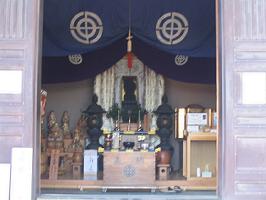 Next to the treasure hall is Daikokudo Hall (大黒堂) dedicated to another Daikokuten, which belongs to the Seven Deities of Good Fortune of Kamakura and Enoshima.
Next to the treasure hall is Daikokudo Hall (大黒堂) dedicated to another Daikokuten, which belongs to the Seven Deities of Good Fortune of Kamakura and Enoshima.
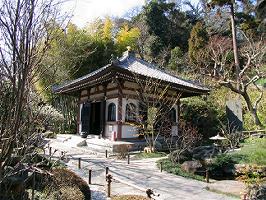 Coming out of Daikokudo Hall and walking forward a little, you will come across Kyodo Hall (経堂 Sutra Hall), containing a rinzo (輪蔵), a rotating repository of Buddhist sutras. This one holds the Issai-kyo Sutra (一切経), which literally means the entire Buddhist canon. One rotation of this repository is said to be the equivalent of chanting all the sutras contained therein. This particular structure was built in the Edo period and moved here from a temple in Hachioji (八王子, in western Tokyo). It is open to the public.
Coming out of Daikokudo Hall and walking forward a little, you will come across Kyodo Hall (経堂 Sutra Hall), containing a rinzo (輪蔵), a rotating repository of Buddhist sutras. This one holds the Issai-kyo Sutra (一切経), which literally means the entire Buddhist canon. One rotation of this repository is said to be the equivalent of chanting all the sutras contained therein. This particular structure was built in the Edo period and moved here from a temple in Hachioji (八王子, in western Tokyo). It is open to the public.
Outside Kyodo Hall is a rest area called Choontei (潮音亭). Its observation deck commands a fine view of Kamakura Beach with the Miura Peninsula in the background. Nearby is a bust of Kume Masao (久米正雄, 1891-1952), a man of letters who once lived in Hase and was active in leading efforts to revive the cultural aspects of Kamakura, a city he loved dearly.
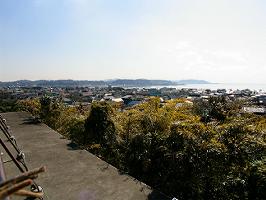
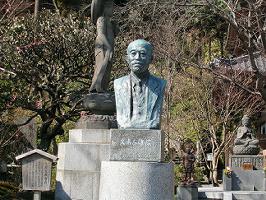
Further on, you will see a stone on which the stylized footprints of the Buddha are inscribed, and a stone statue of Shakyamuni guarded by the Four Deva Kings (or Four Heavenly Kings, 四天王).
Going down the stairway to the lower grounds, visitors can enjoy a stroll around the ponds at the foot of the hill or take a rest while viewing the scenery. The center one is Hojoike Pond (放生池), for the holding of a hojoe (放生会), a ceremony in which captive fish and birds are set free, to gain religious merit.
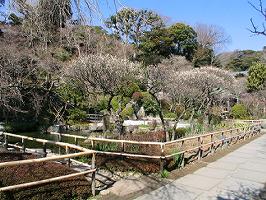
Beyond the ponds and to the right is Bentendo Hall (弁天堂), which houses an image of Benzaiten (弁才天) attributed to Kobo Daishi(弘法大師, 774-835). Benzaiten, or Benten (弁天) for short, a god of water and art, is often enshrined at a pond, river, or spring, and worshiped by many true and would-be artists, especially musicians.
Behind the hall is a cave called Benten Kutsu (弁天窟), related to another Benten. On its rear wall is a carving of Benten holding a biwa (琵琶), a type of stringed musical instrument, and images of Jurokudoji (十六童子) on either side of Benten.
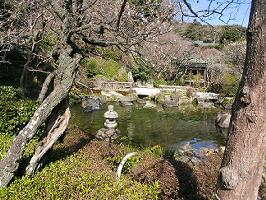
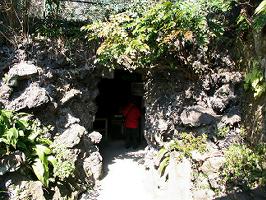
|
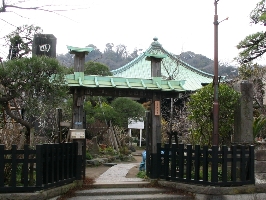
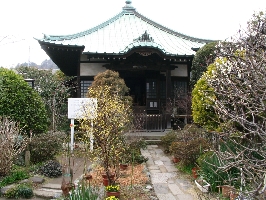
The full name: Shijozan (四条山) Shugenji
Sect: Nichiren sect of Buddhism
Location: One hundred meters north of Hase Station on the Enoden Line.
History:
The temple grounds were once the site of the residence of Shijo Kingo Yorimoto (四条金吾頼基, ?-?), who, as the following story illustrates, was a fervent and self-sacrificing disciple of Nichiren (日蓮, 1222-82), founder of the Nichiren sect of Buddhism.
In September of 1271, Nichiren was arrested at his hermitage and taken to the execution grounds at Yuigahama Beach by the followers of Hojo Tokimune (北条時宗, 1251-84). Nichiren had been actively attacking other Buddhist sects, asserting that social disorder, plagues, and famines were the results of the erroneous teachings of the other sects, and that only his own teaching could bring salvation. The Hojo government, no longer able to overlook such action, decided to execute him.
Shijo Kingo, upon hearing of Nichren's imminent execution, rushed to the execution grounds in Yuigahama together with his brother and begged the executioner to execute him in place of Nichiren. His petition was rejected, however, and he was sentenced to a term in prison. Moreover, his estate was confiscated by his master, Ema Mitsutoki (江馬光時,?-?). Yet despite such ordeals, Yorimoto never lost his faith in Nichiren.
In the Edo period (1603-1867), a nun by the name of Myokei Ni (妙詣尼,?-?) built a temple called Shugen'an (収玄庵) on this site in connection with Nichiren. In 1923, Nichiji (日慈, ?-?), a priest from the nearby Kosokuji Temple (光則寺) built the Main Hall, which, after the Second World War, became formally independent as Shugenji Temple.
Grounds:
It nestles modestly among nearby homes, and seasonal flowers grace the garden. Within the black-gated grounds stands a tall stone monument bearing the inscription, 四条金吾邸跡, which identifies the site as the former residence of Shijo Kingo.
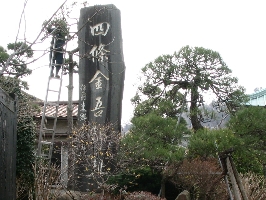 The inscription is in the handwriting of Togo Heihachiro (東郷平八郎, 1847-1934), a Fleet Admiral of the Japanese Imperial Navy, who, as Commander-in-Chief, led the combined fleet to victory in the Russo-Japanese War in 1905. Togo was also an ardent follower of the Nichiren sect.
The inscription is in the handwriting of Togo Heihachiro (東郷平八郎, 1847-1934), a Fleet Admiral of the Japanese Imperial Navy, who, as Commander-in-Chief, led the combined fleet to victory in the Russo-Japanese War in 1905. Togo was also an ardent follower of the Nichiren sect.
The Main Hall houses images of Nichiren, and Shijo Kingo and his wife.
|
|
Goryo Jinja Shrine (御霊神社)
|
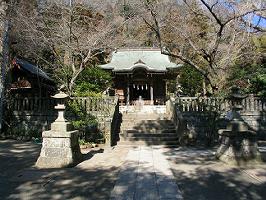 Dedicated Deity: Kamakura Gongoro Kagemasa (鎌倉権五郎景政(正))
Dedicated Deity: Kamakura Gongoro Kagemasa (鎌倉権五郎景政(正))
Location: Three hundred meters west of Hase Station on the Enoden Line.
History:
A story has it that the shrine was dedicated to the ancestors of the five sub-families of the Taira clan, who once lived in and around Kamakura: the Kamakura (鎌倉), Kajiwara (梶原), Muraoka (村岡), Nagao (長尾), and Oba (大庭). Over the course of time, Kamakura Gongoro Kagemasa, who lived and contributed to the development of this area, came to be worshiped as the deity of this shrine because of his valor on the battlefield. He was a paragon of the warrior ideals. Even today he is respectfully referred to as Gongoro-sama (権五郎さま).
Story (1): At the age of sixteen, Kagemasa is said to have taken part in the Go-sannen no Eki (後三年の役 , the Later Three Years' War, 1083-87), which was led by Minamoto no Yoshiie (源義家, 1039-1106) in the northern part of the country called Dewa (出羽, in present-day Yamagata and Akita Prefectures).
One story recounts that when Yoshiie's forces attacked Kanazawa no Saku Castle (金沢の柵), Kagemasa fought bravely but was wounded in the right eye by an enemy arrow. Without pulling it out, he shot and killed his opponent.
After the battle he returned to camp with the arrow still in his eye, but upon removing his helmet, he immediately collapsed, whereupon Miura Tametsugu (三浦為次(継)), another warrior, attempted to remove the arrow by placing his foot on Kagemasa's face. Drawing his sword, Kagemasa shouted, “I would be content to be killed by an enemy arrow, but am I to tolerate the insult of having my face stepped on?" Tametsugu, deeply regretting his action, then dislodged the arrow by steadying Kagemasa's head with his knee.
All the warriors present were impressed and praised Kagemasa's bravery, exclaiming that despite being seriously wounded he still displayed a warrior's dignity. Later, as word of his courage spread, this shrine came to be dedicated to him and, because of that episode, was noted for curing diseases of the eyes.
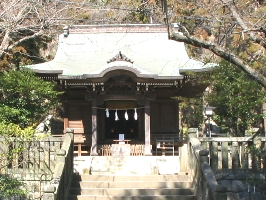
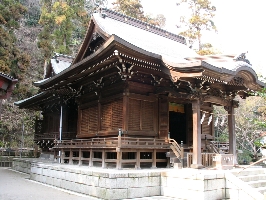
Grounds:
Within the grounds stands a tall, 350-year-old tabu (タブ) tree. Behind the tree is a short flight of stone steps. At the top are shrine halls, actually two structures connected by a small hall. The front building is a Worship Hall (Haiden, 拝殿), pairs of golden arrow feathers, yabane (矢羽根), on its roof. The hall behind it is the Main Hall and has even more elaborate carvings.
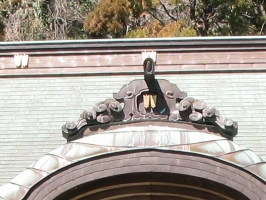 The shrine crest, a pair of arrow feathers, is said to have been Kagemasa's. The shrine is one of the oldest in Kamakura, having been erected before the Kamakura period (1185/92-1333), although the present structures are reconstructions, built in 1913.
The shrine crest, a pair of arrow feathers, is said to have been Kagemasa's. The shrine is one of the oldest in Kamakura, having been erected before the Kamakura period (1185/92-1333), although the present structures are reconstructions, built in 1913.
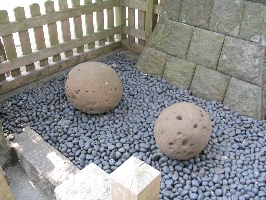 To the right of the Main Hall are two large, round stones connected with Kagemasa: one, called Tamoto-ishi (袂石), literally, “Sleeve Stone" or “Stone in Sleeve," weighs 38 kg; the other, called Tedama-ishi (手玉石), “Juggling Stone," weighs 68 kg. The names suggest that Kagemasa was so powerful that he could carry the heavy stone in his sleeve and playfully juggle the other.
To the right of the Main Hall are two large, round stones connected with Kagemasa: one, called Tamoto-ishi (袂石), literally, “Sleeve Stone" or “Stone in Sleeve," weighs 38 kg; the other, called Tedama-ishi (手玉石), “Juggling Stone," weighs 68 kg. The names suggest that Kagemasa was so powerful that he could carry the heavy stone in his sleeve and playfully juggle the other.
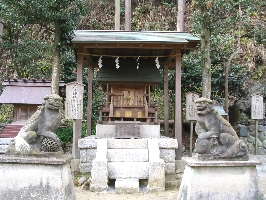 The shrine's courtyard has some small shrines: one is Ishigami Jinja Shrine (石上神社). This is popularly called Ishigami-sama (石上さま), dedicated to a huge rock whose upper section was brought from under the water off Sakanoshita Beach. In olden times, the rock was below the surface at high tide, causing many shipwrecks and claiming a number of lives. Local people attributed the casualties to the anger of the sea god, and built this shrine to pacify it.
The shrine's courtyard has some small shrines: one is Ishigami Jinja Shrine (石上神社). This is popularly called Ishigami-sama (石上さま), dedicated to a huge rock whose upper section was brought from under the water off Sakanoshita Beach. In olden times, the rock was below the surface at high tide, causing many shipwrecks and claiming a number of lives. Local people attributed the casualties to the anger of the sea god, and built this shrine to pacify it.
The shrine's annual festival, gokunagashi (御供流し), takes place on the Sunday nearest July 25th.
That day also marks the opening of the beach for the summer swimming season. A decorated ship with a Shinto priest and a portable shrine aboard, escorted by several other boats, makes its way two kilometers off shore to the spot where the lower section of the rock lies. Young men bearing offerings swim to the rock and pray to the deity for safe sailing.
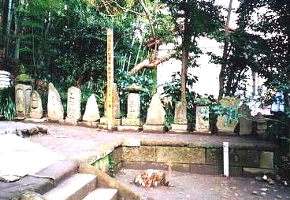 Twelve Koshinto-type (庚申塔) stone monuments, two of which are inscribed with the year names 延宝元年 and 文政八年 (1673 and 1825, respectively), were rescued from a road construction site nearby and form a line at the rear. Generally, koshinto stone monuments stood at the entrance of a village or town in the hope of keeping out wrongdoers, evil events and plagues.
Twelve Koshinto-type (庚申塔) stone monuments, two of which are inscribed with the year names 延宝元年 and 文政八年 (1673 and 1825, respectively), were rescued from a road construction site nearby and form a line at the rear. Generally, koshinto stone monuments stood at the entrance of a village or town in the hope of keeping out wrongdoers, evil events and plagues.
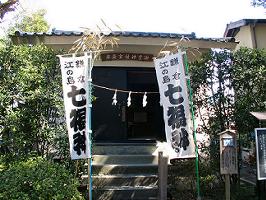
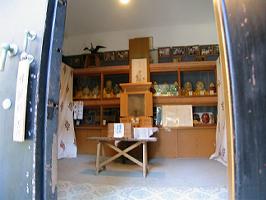
There is also a Treasure Hall, which houses ten old masks with amusing, exaggerated expressions. (See Story(2))
One of the masks is of Fukurokuju (福禄寿), the god of happiness, prosperity, and longevity. Because of him, this shrine is included in the circuit tour of the Seven Good Luck Deities of Kamakura and Enoshima.
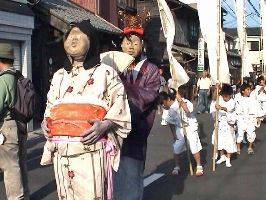 Story (2):
Menkake Gyoretsu or Mask Procession (面掛行列)
Story (2):
Menkake Gyoretsu or Mask Procession (面掛行列)
The annual festival is held from September 12th to 18th. The highlight, the last day, is a procession, called menkake gyoretsu, of local people wearing weird masks.
There are ten masks: a jii (爺 old man), hyottoko (ひょっとこ man with a funny, distorted face), Fukurokuju (福禄寿 one of the Seven Deities of Good Fortune), okame (おかめ woman with a round, flat face), oni (鬼 ogre), hananaga (鼻長 long-nosed male face), igyo (異形 man of unusual and monstrous appearance), okina (翁 old man with a noble face), karasu-tengu (烏天狗 goblin with a crow-like bill), and onna (女 woman).
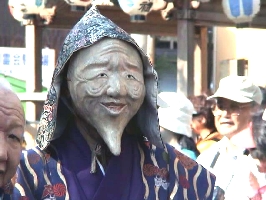
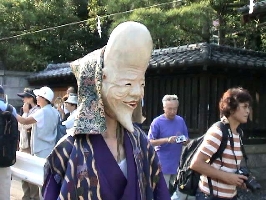
Ten masked men led by a man wearing a long-nosed mask, tengu (天狗), march in procession ahead of portable shrines. In the parade is someone wearing an okame mask and a simple kimono (着物), with a large bulge in front to indicate that the wearer is pregnant.
A marcher wearing a crown called tenkan (天冠) attends the expectant mother, continuously cooling her with a large fan. The parade meanders through the streets with the participants all the while making amusing gestures.
The main object of the parade - a wish for prosperous posterity - is obviously connected to hopes for a good harvest.
The origin of this strange procession harks back to the time of Minamoto no Yoritomo (源頼朝, 1147-99). The procession has been designated an Intangible Folk Cultural Asset by Kanagawa Prefecture. The parade is often featured on the news.
|
|
Chikaramochi-ya Japanese Confectionery Shop (力餅家)
|
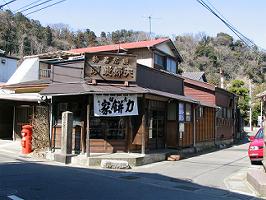 On the corner leading to Goryojinja Shrine from the main road stands a traditional-style confectionery shop, called Chikaramochi-ya. One of its popular items is "Chikara-mochi," literally a soft, fortifying rice cake, hinting at the legend of Hercules-like Kamakura Gongoro Kagemasa.
On the corner leading to Goryojinja Shrine from the main road stands a traditional-style confectionery shop, called Chikaramochi-ya. One of its popular items is "Chikara-mochi," literally a soft, fortifying rice cake, hinting at the legend of Hercules-like Kamakura Gongoro Kagemasa.
|
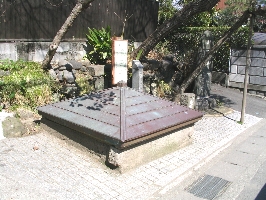 Hoshi no I, “Star Well," was one of the ten most famous wells in old Kamakura. The well is now sealed shut and cannot be looked into, much less have water drawn from it, but it is supposed that travelers in olden times rested here and drank its water. Before the introduction of the present mains water network, the well was in full use and the water sold to passers-by.
Hoshi no I, “Star Well," was one of the ten most famous wells in old Kamakura. The well is now sealed shut and cannot be looked into, much less have water drawn from it, but it is supposed that travelers in olden times rested here and drank its water. Before the introduction of the present mains water network, the well was in full use and the water sold to passers-by.
It is said that in those days this area was so thick with trees that it was dark even in the daytime, so when one looked into the well, stars could be seen reflecting on the water's surface; hence the name of the well. A local story has it that when a lady came to draw water one day, she accidentally dropped a kitchen knife into the well. Her carelessness, it is said, caused an end to the reflection of the stars.
A note on the stars: the word “hoshizukiyo" (starry night) became so popular that in poetry it had to be mentioned first whenever the name Kamakura was used. This kind of word, called makura kotoba (枕詞, literally, a pillow word), is a convention used in waka (和歌) poetry to modify certain fixed words. Its first appearance can be traced to the Heian period.
|
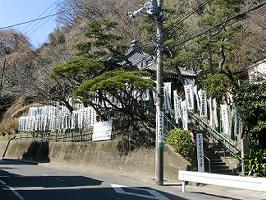
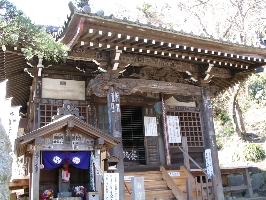
At the top of a stone stairway lined with white banners is a hall called Kokuzodo. The hall is now in the charge of Jojuin Temple (成就院), located across the street.
Kokuzo Bosatsu (Bodhisattva), the main image in the hall, is believed to have infinite virtue and wisdom, and generously grants benefits to all people, accepting every kind of prayer.
Legend has it that when Gyoki (行基, 668-749), a noted priest, was on an ascetic pilgrimage across the country, he held a Buddhist rite here dedicated to Kokuzo Bosatsu (虚空蔵菩薩), and a miraculous event took place.
Over a seven-day period, he saw three blinking lights at the bottom of a near-by well, as if stars were reflected in a mirror. Thinking that something mysterious must be at the bottom, he had the object pulled up. It turned out to be a stone of an unusual shape. He believed it to be a manifestation of Kokuzo Bosatsu, and that it was appearing in order to make people more devout.
Upon hearing of this event, Emperor Shomu (聖武天皇 701-756) requested Gyoki to carve an image of Kokuzo from the stone. When it was finished, Gyoki enshrined it in the Kokuzodo Hall (虚空蔵堂). This is one of three Kokuzo Bosatsu statues in Japan and is highly valued.
In some districts of Japan, parents bring their children to visit Kokuzo Bosatsu when they are 13 years old in order to obtain wisdom, a custom that is called jusan-mairi (十三参り), "thirteen-year-old visit." Kokuzo is the guardian of lacquer ware craftsmen and other artisans, as well as singers, both popular and classical.
Just to the left in front of Kokuzodo Hall is a statue of Funamori Jizo (舟守地蔵), unusual in that it stands on a pedestal in the shape of a boat. This Jizo grants favors closely related to nautical matters such as safe voyages and a good catch.
|
|
Kamakura Museum of Literature (鎌倉文学館)
|
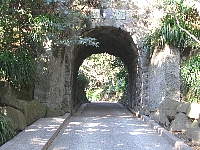
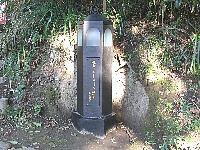 Beyond the entrance is a short tunnel called Shokakudo (招鶴洞), literally a “crane-inviting grotto." The path that runs through the tunnel up to the museum entrance is lined with lamp posts. On each lamp post is written a song or poem composed by a famous writer or poet closely associated with Kamakura, including such luminaries as Minamoto no Sanetomo (源実朝, 1192-1219), Matsuo Basho (松尾芭蕉, 1644-94), and Masaoka Shiki (正岡子規, 1867-1902).
Beyond the entrance is a short tunnel called Shokakudo (招鶴洞), literally a “crane-inviting grotto." The path that runs through the tunnel up to the museum entrance is lined with lamp posts. On each lamp post is written a song or poem composed by a famous writer or poet closely associated with Kamakura, including such luminaries as Minamoto no Sanetomo (源実朝, 1192-1219), Matsuo Basho (松尾芭蕉, 1644-94), and Masaoka Shiki (正岡子規, 1867-1902).
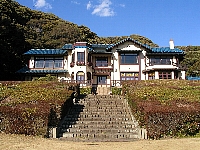 The museum building, constructed in 1936, is a rare example of Western-style architecture, with its blue roof, cream-colored wall, stained glass and balconies. A villa built in 1890 by the Maeda family previously stood on this site.
The museum building, constructed in 1936, is a rare example of Western-style architecture, with its blue roof, cream-colored wall, stained glass and balconies. A villa built in 1890 by the Maeda family previously stood on this site.
The Maeda were known popularly throughout Japan as the lords of Kaga with their million koku, the Kaga Hyakuman Goku (加賀百万石), which denoted the huge size of their domain. Tokyo University stands on their estate in Edo (Tokyo). In 1983 the Hase estate was donated to the city of Kamakura.
From the late 19th century, many literary greats lived and wrote their works in Kamakura. Even today, many well-known literati are active here. Against such a background came the city's decision to preserve the valuable archives associated with Kamakura and to assist in any research on them. This was achieved with the completion of the Kamakura Museum of Literature, which holds some 100,000 books.
The museum displays Kamakura-related literary works, and items such as photos, books, manuscripts, and letters of the Kamakura literati: Kawabata Yasunari, Kobayashi Hideo (小林秀雄, 1902-83), Takami Jun (高見順, 1907-65), Kume Masao, Nagai Tatsuo (永井龍男, 1904-90), Kubota Mantaro (久保田万太郎, 1889-1963), Osaragi Jiro (大仏次郎, 1897-1973), Kon Hidemi (今日出海, 1903-84), Nakayama Gishu (中山義秀, 1900-69), Kojima Seijiro (小島政二郎, 1894-1994), Nakamura Mitsuo (中村光夫, 1911-88) and Satomi Ton (里見弴, 1888-1983).
Twice a year, in the spring and fall, exhibitions are held here focusing on themes suited to the season, and on the personality, activity and life of one of the literati.
From the balcony, visitors can also enjoy the view of the sea beyond the Hase area below. The garden is dominated by a three-tiered lawn, with the lowest tier devoted to roses. Close-by is a monument, Tanemaku-hito (種まく人), The Sowers, commemorating Komaki Omi (小牧近江, 1894-1978), a social scientist.
|
|
Former site of Chorakuji Temple (長楽寺跡)
|
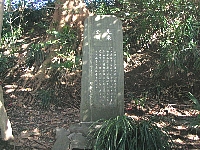 Chorakuji, a no-longer-existing temple, was built in 1225 by order of Masako, the wife of Yoritomo, six years after her husband's death, to pray for the repose of his soul. Attesting to her power, the temple boasted seven major structures in the 800-meter square grounds. The temple is said to have burned down between 1331 and 1333, although this is uncertain.
Chorakuji, a no-longer-existing temple, was built in 1225 by order of Masako, the wife of Yoritomo, six years after her husband's death, to pray for the repose of his soul. Attesting to her power, the temple boasted seven major structures in the 800-meter square grounds. The temple is said to have burned down between 1331 and 1333, although this is uncertain.
Today a stone marker explaining that the temple stood here and only the place name, Chorakuji, reminds us of its glorious days.
|
|
The Hase Kodomo Kaikan, Hase Children's Hall, the former Moroto Residence (長谷子供会館)
|
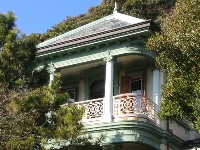 This hall has the appearance of an ancient Greek temple. It was built in 1908 and later transferred to the ownership of Moroto Seiroku (諸戸清六), a magnate in the agricultural and forestry business, who then donated it to the city.
This hall has the appearance of an ancient Greek temple. It was built in 1908 and later transferred to the ownership of Moroto Seiroku (諸戸清六), a magnate in the agricultural and forestry business, who then donated it to the city.
The first floor has a mantelpiece and the walls of the rooms are superbly decorated. A balcony on the second floor offers a fine view of the sea and recalls the good old days of Kamakura when it was a seaside resort.
The hall is now used as a gathering place for neighborhood children of elementary and junior high school age. It is not open to the public.
|
|
Kawabata Yasunari Memorial Hall (川端康成記念会)
|
The hall, not open to the public now, was originally the home of Kawabata Yasunari (川端康成, 1899-1972), winner of the Nobel Prize for literature in 1968 and well-known author of Izu no Odoriko (伊豆の踊子, The Izu Dancer), Yukiguni (雪国, Snow Country), and many other works.
Because of his fondness for Kamakura, Kawabata made this his residence from 1946 till 1972 after living earlier in Jomyoji and Nikaido. He often took strolls through these neighborhoods and wove the scenery and atmosphere into some of his novels, such as Yamanooto (山の音,The Sound of the Mountain, 1970) and Sembazuru (千羽鶴, A Thousand Cranes,1959).
The story of Yamanooto developed around this house. When the book was made into a film by director Naruse Mikio (成瀬巳喜男), a faithful replica of the house was built on set.
|
|
The Former Site of the Adachi Morinaga Residence (安達盛長屋敷跡)
|
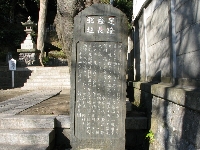 A stone monument at the entrance to Amanawa Shimmeigu Shrine (甘縄神明宮) marks the site of the former residence of Adachi Morinaga (安達盛長, 1135-1200), an influential warrior under Minamoto no Yoritomo. The area that fronts the shrine was his residence.
A stone monument at the entrance to Amanawa Shimmeigu Shrine (甘縄神明宮) marks the site of the former residence of Adachi Morinaga (安達盛長, 1135-1200), an influential warrior under Minamoto no Yoritomo. The area that fronts the shrine was his residence.
Morinaga was a vassal of Yoritomo from 1180, the year that the exiled Yoritomo first decided to take up arms in Izu. When Yoritomo was defeated by the Heike and fled to present-day Chiba Prefecture, he helped Yoritomo regain his power.
After Yoritomo's victory over the Heike, he was highly esteemed by Yoritomo and granted an estate here, an important location from a strategic point of view. When Yoritomo came to the shrine to pay his respects, he would often stop and visit the mansion.
|
|
Amanawa Shimmeigu Shrine (甘縄神明宮)
|
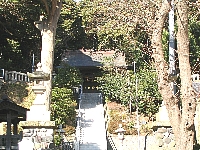 The enshrined deity is Amaterasu Omikami (天照大御神), the Sun Goddess. The “ama" in Amanawa supposely signifies "woman diver," and the “nawa" a "fishing net." Amanawa Shimmeigu Shrine was built during the Wado era (和銅,708-715) by Someya Taro Tokitada (染谷太郎時忠, ?-?), a powerful leader in this area. The shrine is the oldest in Kamakura and serves as the tutelary deity of the Hase area, an indication that this area was one of the earliest to be settled.
The enshrined deity is Amaterasu Omikami (天照大御神), the Sun Goddess. The “ama" in Amanawa supposely signifies "woman diver," and the “nawa" a "fishing net." Amanawa Shimmeigu Shrine was built during the Wado era (和銅,708-715) by Someya Taro Tokitada (染谷太郎時忠, ?-?), a powerful leader in this area. The shrine is the oldest in Kamakura and serves as the tutelary deity of the Hase area, an indication that this area was one of the earliest to be settled.
Following a visit here by Minamoto no Yoriyoshi (源頼義, 988-1075), governor of Sagami Province (相模国, present-day Kanagawa Prefecture), a son, Yoshiie (義家, 1039-1106), was born, and the enshrined god became Yoshiie's guardian deity. Yoshiie himself reconstructed the shrine, an act which underscores its close relationship with the House of Genji.
In the Kamakura period, many leading figures of the bakufu often came to worship, including Yoritomo (頼朝, 1147-99), Masako (政子,1157-1225), and Sanetomo (実朝, 1192-1219).
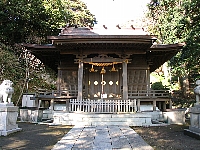
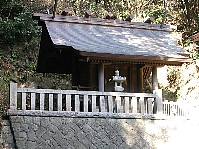
At the top of the steep stone steps is Haiden Hall (Worship Hall) with its artfully arranged roof of five katsuogi (鰹木, short wooden logs arranged horizontally) on its ridge, and two chigi (千木, cross planks arranged in an X-shape) at either end.
The entire structure is fairly new, having been built in the Showa period (1926-1989), and has elaborate carving. Between Haiden Hall and a hill at the rear is the Main Hall, somewhat smaller than Haiden Hall but with a more elaborate structure. The grounds overlook the rooftops and streets of the Hase area and offer a fine view of Yuigahama Beach.
The shrine holds its annual festival on 14th September, and area becomes crowded with portable shrines, floats and parades.
|
Norishin Anzai Shoten, a processor of agricultural and marine products
のり真安斉商店
|
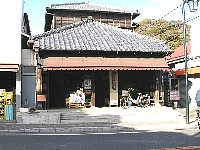
This structure was built in 1924, one year after the Great Kanto Earthquake, for a processor and wholesaler of agricultural and marine products. The elaborate shop front reminds us that Hase was a prosperous business district in the old days.
The shop retains typical features of the Taisho era and is also reminiscent of earlier Edo-era shops: stone foundation, earthen floor, low wooden counter, and timber push-up window shutters, instead of glass-paned sliding doors. At the rear of the store, there is a Western-style storehouse-cum-residence built in 1938.
Also of particular interest is an old signboard that says the shop specializes in the traditional items, including dried seafood, exchanged at (marriage) engagement ceremonies and various samples are displayed at the back of the store.
The shop has been designated a building of important architectural value by the city.
|
Yoshiya Nobuko Museum 吉屋信子記念館
|
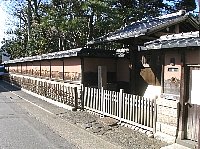 Yoshiya Nobuko (吉屋信子, 1896-1973), a novelist, lived in Kamakura during the Second World War. In 1962 she built this house (the present museum) and remained active here until her death. She willed her home to the City of Kamakura, stating that she felt she should return something to the society that had given her so much and that the property should be used to promote women's cultural and educational activities. Accordingly, the city government has preserved as a museum this traditional wooden house and Japanese-style garden in its quiet setting.
Yoshiya Nobuko (吉屋信子, 1896-1973), a novelist, lived in Kamakura during the Second World War. In 1962 she built this house (the present museum) and remained active here until her death. She willed her home to the City of Kamakura, stating that she felt she should return something to the society that had given her so much and that the property should be used to promote women's cultural and educational activities. Accordingly, the city government has preserved as a museum this traditional wooden house and Japanese-style garden in its quiet setting.
The study remains as Yoshiya left it, and items such as her handwritten manuscripts and favorite objects are on display as reminders of her life. Two of her books, Tokugawa No Fujintachi (徳川の夫人たち, 1966) and Nyonin Heike (女人平家, 1971) were written in this house.
The museum is open twice a year, in early May and November, for three days each time.
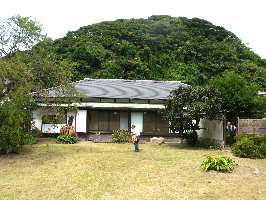
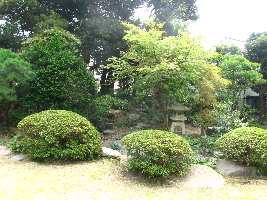
|
Former site of the Someya Tokitada residence (染谷時忠邸跡)
|
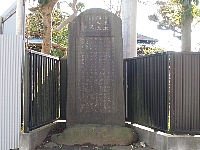 Yuigahama area(由比ガ浜) was one of the busiest parts of Kamakura in the Heian period. In this area was the residence of Someya Tokitada (染谷時忠, ?-?), a wealthy military commander in those days.
Tokitada was a descendant of Fujiwara no Kamatari (藤原鎌足, 614-669), the founder of the celebrated Fujiwara family in the Heian period. And furthermore his father was Ryoben (良弁, ?-?), the priest who contributed to the founding of Todaiji Temple (東大寺) in Nara (奈良). Tokitada lived here from the end of the seventh to the early eighth centuries.
Yuigahama area(由比ガ浜) was one of the busiest parts of Kamakura in the Heian period. In this area was the residence of Someya Tokitada (染谷時忠, ?-?), a wealthy military commander in those days.
Tokitada was a descendant of Fujiwara no Kamatari (藤原鎌足, 614-669), the founder of the celebrated Fujiwara family in the Heian period. And furthermore his father was Ryoben (良弁, ?-?), the priest who contributed to the founding of Todaiji Temple (東大寺) in Nara (奈良). Tokitada lived here from the end of the seventh to the early eighth centuries.
The following stories tell of his great influence in this area. One is that he was so wealthy that he was called Yui no Choja (由比ノ長者). "Choja"means a billionaire, so he was literally billionaire of the Yui area. The second is that a nearby area has the name, Chojakubo, which again suggests his richness. The third is Tokitada is said to have had the nearby Amanawa Shinmeigu Shrine built.
The stone monument, which tells of his activities, stands 150 meters from Yuigahama-odori on the street running in front of Yuigahama Station on the Enoden Line.
|
|
|
|